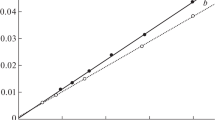Summary
The influence of noise on the accuracy and precision of the measurements of peak area and retention time have been assesed for symmetrical peaks. Unfortunately real peaks are more or less unsymmetrical, most of them exhibiting some degree of tailing. To reach a given precision level the width of the time window in which measurements have to be carried out increases with the asymmetry of the peaks. The effect of the peak tail on the precision and accuracy of the measurements of retention time is discussed and exemplified on chromatograms obtained by simulation or given by a high precision equipment. It is shown that the adjustment of an exponential curve on the peak tail reduces the systematic and random errors made while allowing measurements to be made in a narrower window. For example, with a Cram type II peak with a signal-to-noise ratio of 75 the error is reduced from 18% to 2% by fitting an exponential on the peak tail.
Résumé
L'influence du bruit sur la détermination de l'aire et du temps de rétention d'un pic chromatographique a déjà été étudièe, particulièrement dans le cas de pics symétriques [1]. Malheureusement, la plupart des pics réels sont, à des degrés divers, rendus non symétriques par la présence d'une trainée. Or, pour un niveau de précision donné, plus un pic est dissymétrique, plus les mesures doivent être faites dans une large fenêtre, et ce, d'autant plus que l'ordre du moment s'élève [2]. Après avoir dégagé l'importance de ce problème pour la détermination précise du temps de rétention d'un pic dissymétrique, nous verrons comment l'ajustement d'une exponentielle sur la trainée du pic permet d'augmenter la justesse du temps de rétention, tout en rédusiant la largeur de la fenêtre pendant laquelle est mesuré le signal. Cetre étude montre par exemple que sur un profil simulé du type Cram II avec un rapport signal sur bruit de 75, l'ajustement d'une exponentielle peut réduire l'erreur commise de 18% à 2%.
Similar content being viewed by others
References
M. Goedert, G. Guiochon, J. Chromatog. Sci.11, 326 (1973).
M. Goedert, G. Guiochon, Chromatographia6, 116 (1973).
J. Villermaux, Column Chromatography.E. Kovats ed., Sauerländer, Aarau, Suisse, 1970, p. 66.
J. Villermaux, J. Chromatog. Sci. (à paraître).
T. Petitclerc, G. Guiochon, Chromatographia7, 10 (1974).
S. N. Chesler, S. P. Cram, Anal. Chem.43, 1922 (1971).
M. Goedert, G. Guiochon, Anal. Chem.45, 1188 (1973).
Author information
Authors and Affiliations
Rights and permissions
About this article
Cite this article
Petitclerc, T., Guiochon, G. Détermination du temps de rétention d'un pic dissymétrique. Influence de la correction par ajustement d'une exponentielle en fonction du rapport signal sur bruit. Chromatographia 8, 185–192 (1975). https://doi.org/10.1007/BF02274454
Received:
Accepted:
Issue Date:
DOI: https://doi.org/10.1007/BF02274454




